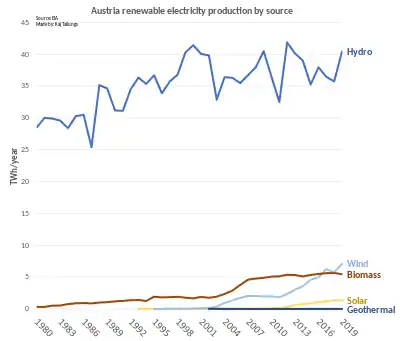Energy in Austria
Energy in Austria describes energy and electricity production, consumption and import in Austria. Austria is very reliant on hydro as an energy source, supported by imported oil and natural gas supplies. It is planned by 2030 to become 100% electricity supplied by renewable sources, primarily hydro, wind and solar.

Energy statistics
|
|
|
CO2 emissions: |
Energy plans
In 2021 Austria passed a Renewable-Expansion-Act (”Erneuerbaren Ausbau Gesetz”, EAG) Nationalrat stipulating a goal of 100% renewable electricity by 2030, meaning that 27 TWh of renewable power need to be added by 2030.[2]
Energy types

Fossil fuels
Imported oil accounted for 35.4% of energy consumed in 2022, gas 16.8 percent.[3]
OMV AG, a multinational integrated oil, gas and petrochemical company, is the largest energy business in Austria, with a turnover of €36 billion in 2021.
Hydro power
With over 3,000 hydro energy plans in operation, in 2021 Hydro power provided 14.1 GW and accounted for 54% of Austria’s total installed power generation capacity and 58% of total power generation.[4]
Hydro power in the summer of 2022 has generated less power, due to water shortages, due to climate changes.[5]
To meet the 2030 plan, an additional 1,500 MW of hydro energy capacity will be needed.[6]
Verbund AG is Austria's largest electricity provider. Verbund covers around 40 percent of electricity demands in Austria and generates 90 percent from hydro power. Annual turnover is around €10 billion.
Renewable energy

| Achievement | Year | Achievement | Year | Achievement | Year |
|---|---|---|---|---|---|
| 25% | 2006 | 30% | 2009 | 35% | 2014[1] |
According to Austrian Environment Minister Nikolaus Berlakovich Austria has a target of 34% renewable energy by 2020 and 100% self-sufficiency in energy by 2050. In Austria will be 100,000 new green jobs up to 2020, Berlakovich hoped in the European Wind Energy Event 2013 by EWEA.[7]
Solar power
Photovoltaic systems contributed almost 6 percent to domestic electricity production in 2022 with 3,792 MW capacity..[3]
1.4 GW of solar energy capacity was added in 2022.[8]
An additional 10.5 GW of solar PV will be needed between 2022 and 2030 to meet the planned renewable target.[6]
Wind power
In 2000 there was just 77 MW of wind capacity, by 2010 this had grown to 1,011 MW. In 2020 there was 3105 MW and in 2023 it had reached 3,573 MW of wind power capacity in Austria.
Some states in Austria have forward looking plans to double the 2021 wind power by 2030 by expanding existing wind parks and creating new ones.[9]
Biomass
Biomass provides over 18% of electricity capacity
Energy use
31.3% of energy in 2021 was used by transport which is the economic sector with the largest consumption of energy in Austria.[10]
References
- "Energy consumption in Austria". 2020.
- "Integrated Power and Economic Analysis of Austria's Renewable Electricity" (PDF). January 2023.
- "Contribution of renewable energies in generation 2022 further increased". 11 August 2023.
- "Hydropower capacity in Austria and major projects". 20 June 2023.
- "Climate change challenges hydropower-dependent Austria". 10 July 2023.
- "Austria - At the Heart of Europe". Retrieved 12 August 2023.
- Fossil fuel subsidies are "public enemy number one" – IEA Chief EWEA 04 Feb 2013
- "Austria estimates up to 1.4 GW of solar additions in 2022". 9 January 2023.
- "Austrian states step up to tap wind energy potential". 20 October 2022.
- "FACTS AND FIGURES - ENERGY INDUSTRY". Retrieved 13 August 2023.
External links
 Media related to Energy in Austria at Wikimedia Commons
Media related to Energy in Austria at Wikimedia Commons